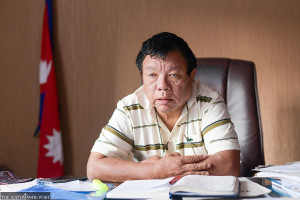Interviews
Conflict can both shrink and expand labour demand
Without proper registration and data collection mechanisms, a government has only limited ability to respond during emergencies or crises.
Purushottam Poudel
As the conflict in West Asia escalates, concerns are growing in Nepal about the safety, mobility, and livelihoods of the hundreds of thousands of Nepali workers in the region. In this interview with the Post’s Purushottam Poudel, labour migration expert and political scientist Jeevan Baniya, who is also deputy director of Social Science Baha, reflects on the implications of rising instability in West Asia for Nepal’s labour economy, the gaps in current labour migration policy, and the systemic vulnerabilities faced by both documented and undocumented Nepali workers abroad.
West Asia has become a hotspot for conflict. In 2023, tensions between Israel and Palestine escalated into open conflict. Now, we are witnessing a flare-up between Israel and Iran. Importantly, this region is a significant destination for Nepali migrant workers. How do you see this dynamic?
Following the outbreak of hostilities between Israel and Palestine in October 2023, there were debates in Nepal about whether to continue sending workers to Israel. When the situation stabilised, the government deemed it safe and resumed the deployment of Nepali workers. In terms of numbers, the Nepali population in Israel remains relatively small. According to official sources on both sides, there are currently an estimated 5,000 to 7,000 Nepalis in Israel.
In 2020, Nepal signed a bilateral labour framework agreement with Israel, allowing sector-based recruitment. Further, a 2023 agreement between the two countries expanded the quota of Nepali caregivers permitted to work in Israel. As a result, the number of Nepalis going to Israel has grown, compared to when most were limited to agriculture jobs. A smaller number also work in construction. However, the number of Nepalis who have travelled to Israel with official labour permits under the bilateral framework is around 2,000.
Besides these workers, the number of Nepalis who migrated to Israel years ago and have since settled there with their families is estimated to number between 500 and 700. There are also Nepali youths involved in technical training or exchange programmes in Israel.
The number of Nepalis in Israel is modest compared to other countries in the region. But the spillover effect of conflict in Israel can easily extend to neighbouring nations. For instance, many Nepali women are employed in apparel factories in nearby Jordan. As such, rising instability in the region could affect Nepal’s economy in a broader sense.
How does conflict in West Asia impact Nepal’s economy?
If a conflict escalates in an economically strategic region, it has direct implications for the labour market. From production through supply to consumption, parts of the economic chain are interconnected. When any link is disturbed, demand falls—something we vividly witnessed during the Covid-19 pandemic. The absence of economic activity during that time had a direct and immediate effect on the labour market.
For instance, Malaysia—a major destination for Nepali workers—saw an economic contraction that reduced employment opportunities for Nepalis. Where once 400,000 to 500,000 Nepalis used to work, the number has since decreased substantially. Similarly, if conflict in West Asia disrupts local economies, demand for foreign workers—including Nepalis—will likely fall.
However, literature on disaster capitalism and the political economy of conflict suggests that conflicts can also create certain types of opportunities. For example, destruction is often followed by reconstruction, requiring labour during the construction phase. Likewise, conflict zones often see a rise in demand for peacekeeping personnel and caregivers. Therefore, conflict not only results in labour market contraction—it can also create specific forms of labour demand, depending on how the post-conflict economy is rebuilt.
What do our current data indicate about the distribution of Nepali labour in the region?
Data available in Nepal largely pertains to workers who have received labour approval before going abroad. This data doesn’t account for Nepalis who have settled abroad long-term or have migrated through informal channels. Hence determining the exact number of Nepalis in any given country remains a challenge.
When cross-referencing destination country data with Nepal’s official records, we find the following estimates—Saudi Arabia: approximately 300,000 to 350,000 Nepalis, Qatar: approximately 400,000; and the United Arab Emirates: 300,000 to 500,000. The high numbers in the UAE can be partially attributed to the large influx of Nepalis initially arriving on visit visas who later got work permits.
Other estimates include approximately 100,000 to 150,000 Nepalis in Kuwait, around 20,000 to 35,000 in Bahrain, and roughly 20,000 in Oman.
If we consider legal and undocumented migration, there could be between 1.1 million and 1.4 million Nepalis working in West Asia.
However, it’s important to note that not all these countries are likely to be drawn into a conflict at the same time. The dynamics vary from one nation to another, and so does their exposure to conflict risks.

Nepalis travel not only to countries with which the government has formal labour agreements, but also to destinations that either lack such agreements or have been placed under official travel restrictions. What are the driving factors behind this phenomenon? What compels Nepalis to travel even to destinations deemed restricted?
Over the years, various labour migration measures have been implemented in phases, such as age-based restrictions or blanket bans on domestic work in certain countries, based on specific incidents. These actions often take the form of broad policy announcements stating that Nepalis may travel to some destinations but not others.
However, Nepal continues to face serious issues concerning job opportunities, availability of decent working conditions, and regular income. Additionally, even though the Government of Nepal may bar travel to certain countries, those countries may not necessarily classify the recruitment of Nepali workers as illegal. This legal grey area creates a loophole.
What we also find is that the majority of Nepalis heading to such restricted countries are not those struggling for food and shelter, but rather individuals from lower-middle class. For them, foreign jobs remain one of the few available means to escape economic insecurity at home. Bureaucratic and procedural hurdles involved in migrating through official channels also lead some people to bypass government restrictions and opt for destinations with which Nepal lacks formal labour agreements.
Kuwait serves as a prime example, where around 50,000 Nepalis are residing illegally. Moreover, while compiling our migration report, we observed that certain destination countries tend to adapt migration policies according to temporary labour market needs. Once those needs are met, they often revert to earlier, more restrictive policies. Therefore, even when Nepal enforces domestic prohibitions, the legal frameworks in the receiving countries may remain open, encouraging migration to those destinations.
Those who migrate for work through official channels are generally recorded in government data, which enables the state to help them should they face difficulties abroad. However, in the case of those who travel illegally or without proper documentation, the government is often unable to offer timely or effective support. How do you see this trend?
Even for those who go abroad legally, there are instances where the government of Nepal does not maintain complete or up-to-date records. For example, not all Nepalis residing in Israel are in contact with the Nepali Embassy. The only way for the embassy to stay in touch with them is if migrants themselves register upon arrival, or if their departure details are recorded by Nepal’s Department of Immigration at the point of exit.
There used to be a provision whereby embassies would handle the renewal of labour permits for migrant workers. If this system had continued, embassies might have maintained more accurate records of the Nepali diaspora in their respective countries. However, under the current system, Nepali workers are required to return home after a certain number of years in order to renew their labour approval.
From a policy standpoint, this requirement may appear justifiable, as it ensures that workers return home and reunite with their families. Yet the lack of reliable and centralised data at the diplomatic missions makes it challenging to extend support to workers who encounter problems abroad.
In essence, without proper registration and data collection mechanisms—especially at the embassy level—the government’s ability to respond during emergencies or crises remains limited, even for those who initially migrated through formal procedures.
There have been instances where despite government efforts to rescue Nepali nationals during times of crisis some individuals have been reluctant to be rescued. What could be the reason for this?
One key reason appears to be the fear of criminalisation. Many who live abroad without legal status are hesitant to come forward, even in difficult circumstances, out of concern that they may face legal repercussions or deportation. However, the International Convention on the Protection of the Rights of All Migrant Workers and Members of Their Families (1990) Article 8 among other laws affirms the human rights of migrants regardless of their legal status and guarantees their right to return to their country of origin during this time of crisis. The host country is obliged to facilitate the safe return of foreign nationals wishing to leave. Importantly, individuals living abroad illegally should not be criminalised simply for seeking safety during such situations.
This underscores the need for clarity in labour agreements. When Nepal signs bilateral labour agreements with destination countries, the provisions should not only cover recruitment, employment conditions, and workers’ rights but also explicitly outline responsibilities during emergencies or crises. Unfortunately, a review of some of Nepal’s recent labour agreements reveals that such crisis-related protocols are often overlooked.
At present, many workers are hesitant to return to Nepal during crises. Not because they don’t wish to come home, but because they are uncertain whether they will be allowed to again go abroad for work afterwards. Without clarity on this issue, even those in distress may choose to remain where they are.
To draw a parallel from other contexts, even after the kafala system was formally abolished in Saudi Arabia and other destinations, challenges persist. In both Saudi Arabia and Malaysia, for instance, workers often still require an exit visa to return to their home countries. During emergencies, such exit visa requirements should be waived, and once conditions in the destination country improve, mechanisms should be in place for workers to return to employment there, should they wish to.
On one hand, it appears that global tensions are on the rise, on the other, in times of crisis, both countries of origin and destination are obliged to ensure the safety of migrant workers. Is Nepal equipped to handle this dual responsibility?
In principle, it is the responsibility of all states to ensure that no one is compelled to migrate illegally for employment. The state must create a system in which migration is managed and regulated.
Further, destination countries must also have provisions for worker registration, even for those who may have become undocumented for various reasons. For instance, the Philippines has implemented a noteworthy system. Filipino workers, even if they lose their legal status for any reason, can register themselves in the host country. Unlike Nepal, where workers are required to contribute to a welfare or social security fund before departure, the Philippines allows its workers to enrol or register while in the destination country as well. If Nepal were to adopt a similar measure, our migrant workers could stay in contact with the government even during emergencies.
We need a system where workers are sent abroad in an organised and dignified manner. Very few people knowingly choose hardship, most are driven by compulsion. Foreign employment, for many Nepalis, is not a luxury but a necessity.




 19.12°C Kathmandu
19.12°C Kathmandu











%20(1).jpg&w=300&height=200)

